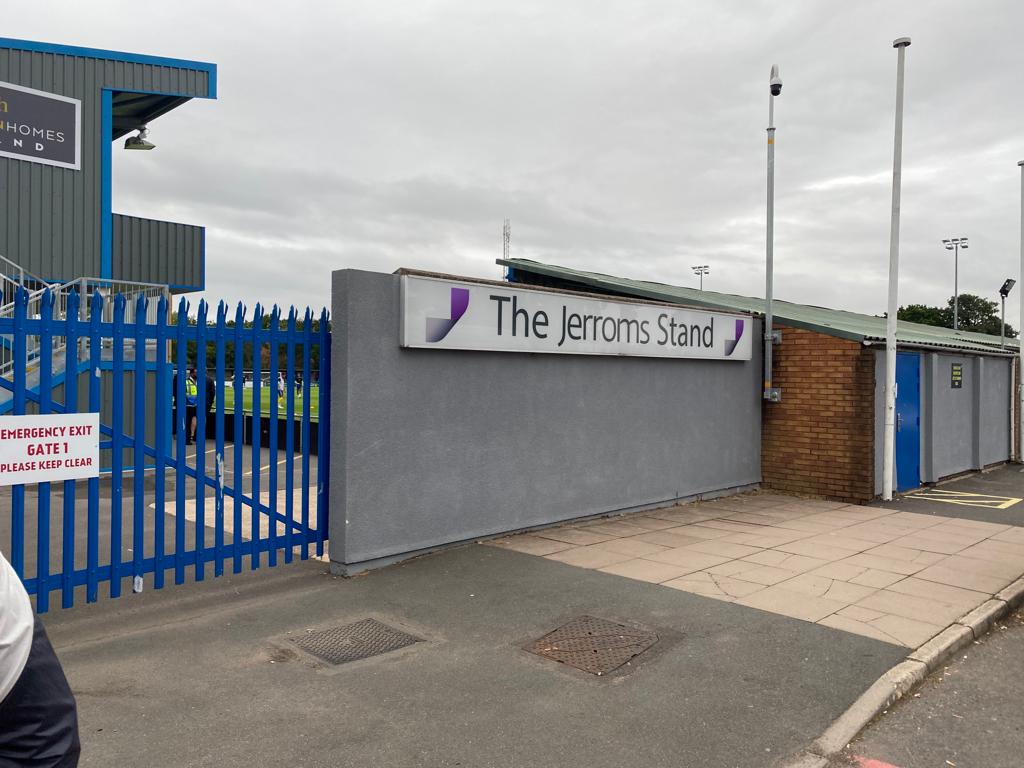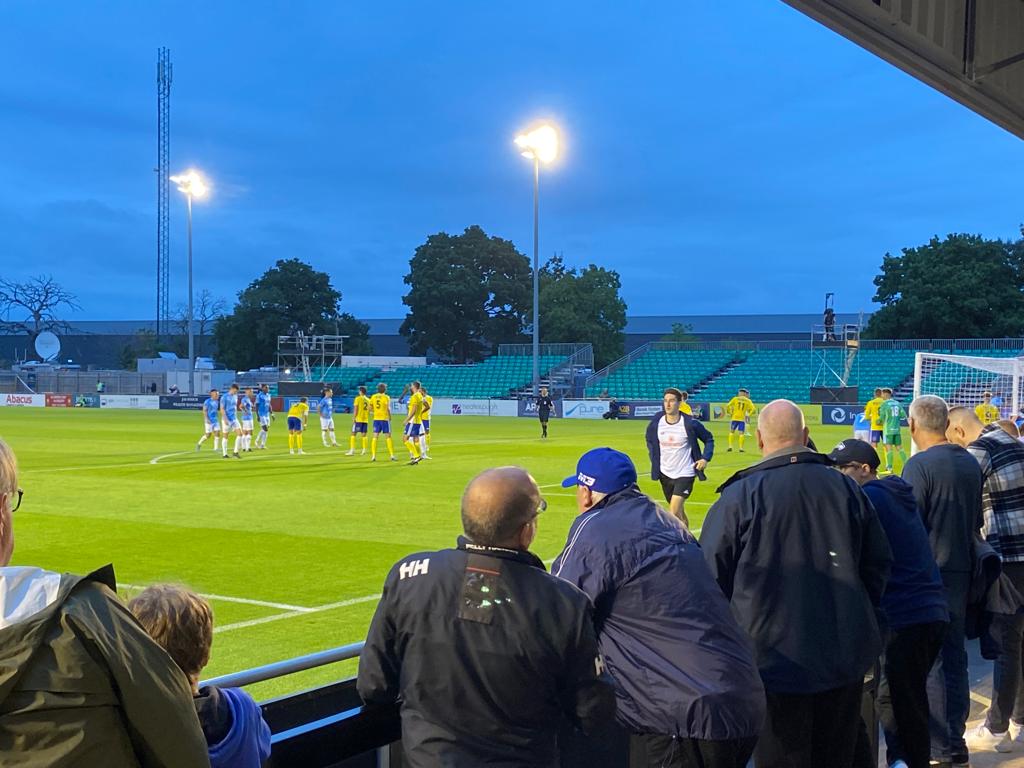The soccer pyramid is sacrosanct to English soccer fans; clubs further down the system are so well-supported that it continues to surprise fans from abroad.
Yet, to the average English match-goer, trips to clubs in lower divisions aren’t out of the ordinary; they’re woven into the fabric of the fan experience every weekend.
We all know about the globally commercialized behemoths like Manchester United and Liverpool and see everything about them so frequently to the point that you’d feel like you’ve already been to Old Trafford or Anfield on your first visit – the same way you might be familiar with Manhattan because of all the movies you’ve seen based there.
So when you stumble across a stadium like Damson Park (or the ARMCO Arena as it’s known for sponsorship reasons), which isn’t well known outside of its local vicinity, there’s a sense of intrigue involved.

For those of you who don’t know them, located in the center of England, there’s a club with big ambitions and their name is Solihull Moors FC.
Not just a marriage of convenience
While many people think of English soccer clubs as being steeped in history and tradition, the Moors are only 15 years old in their current existence, making them one of the youngest professional clubs in the country.
The club’s origins are peculiar; separate entities Solihull Borough and Moor Green weren’t getting enough fans through the turnstiles and were therefore feeling the effects financially.
A simple solution was proposed: merge the two clubs to form one side that the entire town of Solihull could get behind.
Although it was partially a necessity, this unification proved mutually beneficial too. Moor Green’s stadium was sadly involved in an arson attack, so they needed to find a new home. Solihull Borough’s ground was suitable, so it made sense from Moor Green’s perspective.
What did Solihull Borough get out of it? Well, they were lingering in the eighth tier of English soccer at the time, so when the opportunity arose for both clubs to unite and compete in the sixth tier, where Moor Green was competing, it was a no-brainer.
Because Moor Green were the more successful playing side of the two, the majority of the new Solihull Moors squad were players from Moor Green. The badge and kit colors were also closer to what Moor Green had than Solihull Borough.
The names of the respective clubs were amalgamated into what we now know as Solihull Moors, and the club hasn’t looked back since… except when they celebrate their past through commemorative away jerseys in the old Solihull Borough colors of red and white.
Solihull Moors: The club today
Backed by substantial investment from the club’s ownership, Solihull Moors, like most others in the fifth tier of English soccer, is professional.
If you’re a regular at the ARMCO Arena, you’ll have witnessed the rapid rate of change to the club’s infrastructure. Renovated stands and a modernized clubhouse are proof of the direction the owners want to take the club in.
The stadium has gone under vast expansion since the Moors’ promotion from the National League North in 2016.
Successive years surviving in the National League meant the club could inject the extra revenue it received into work on its home in the hope that this would allow further fans to support the team. Rather than survival, the club has eyes on another promotion.
There are fears that the stadium isn’t large enough should the club progress to League Two. Initially, to cope with the uptake in demand for tickets, temporary stands were installed opposite the main stand.
Covered seating is to become a permanent fixture on this side of the ground, however, with work ongoing. It’s estimated that the renovated sideline stand will accommodate over 1,200 seated spectators. Impressive, especially when you consider the modest roots of the club.
Increased spectator figures have almost witnessed Solihull Moors reach the 3rd round of the FA Cup on four occasions in the past six seasons, coming just short each time from a potentially lucrative fixture against a giant of the game.
The lofty ambitions of the club’s hierarchy mean fans can expect, rather than hope, to see the club finally navigate its way beyond the 2nd round of the FA Cup in the future. A helpful platform for doing this on a regular basis would be promotion to the Football League.
Becoming one of the 92 English Football League clubs would bring financial income that the club has yet to see in its existence and should attract bigger names to sign for the club and wear the yellow and blue jersey.
Last season, the Moors lost the National League playoff final in extra time. Having battled sides more fancied than themselves for promotion, the Moors were one game away from becoming one of ‘The 92’ but couldn’t get the job done.
This brutal manner of defeat left Solihull stranded once again outside the Football League, falling at the last hurdle in their season’s objective.
Despite this missed opportunity last season, optimism remains high at the ARMCO Arena. Many feel the Moors were punching a bit above their weight to make the playoffs, yet still believe the club is on the right trajectory going forward.
York City come to town

You could tell from the fans in attendance that spirits weren’t dampened from the 2021/22 campaign’s heartbreak. York City was the visitor on my trip to the Moors, and I was eager to see if they could maintain, or even improve on, the performance levels from the prior term.
One thing I noticed when watching Solihull Moors was that there were a lot of Aston Villa and Birmingham City merchandise worn by those in attendance. The Moors do a very good job of attracting fans of both of these clubs to their games when their more illustrious neighbors aren’t playing.
Making those visitors switch from infrequent drop-ins to die-hard regulars is extremely difficult, and executives at the Moors know this. With so many elite games moved to accommodate TV broadcasters, clever pricing strategies at the Moors are introduced to attract fans of bigger clubs when their ‘main’ teams aren’t playing, like £5 off your ticket price if you are a season-ticket member at another West Midlands club.
There’s a tendency from fans of wealthy and successful clubs to hold prejudices about lower-league soccer: being crammed into outdated terraces, cold and unappetizing food, and a brutal form of soccer with very little skill involved.
At Solihull Moors, this isn’t the case and hasn’t been for a while.
Gone are the days of bruising physicality reigning supreme as the sole attribute among non-league football teams. Now that most clubs are professional at this level, there’s plenty of skill on show.
Nor is the food simply inedible. In fact, I couldn’t resist buying a “Monster Hot Dog” from the food van after spotting them on the grill, and, let me tell you, it was certainly monstrous! It was simple but effective; no frills, just good value for money. When the food at soccer stadiums is done right, you can’t beat it, and the Moors delivered.
Yet, on the field, Solihull couldn’t match their culinary expertise. A tight affair that evening with few chances saw the away side, buoyant from their promotion to the National League, frustrate the Moors to take a point back to Yorkshire.
Despite what I said regarding higher-quality soccer, this game probably wasn’t the best example of it. There were some nice interchanges between midfielders throughout, but a poor end product hurt the Moors when they needed to show some class in the final third of the field.
A 1-1 scoreline was ultimately fair. This game won’t live long in the memory of the 1,125 in attendance, but the traveling contingent would certainly have been the happier of the two sets of fans.
Solihull Moors: A new dawn
There was a certain charm to those Saturday afternoons following the club before promotion when they were struggling in the sixth tier of English soccer.
The battered pool table upstairs in the bar was positioned so you could watch the game’s action (at least a view of one goal anyway) from the comfort of the indoors on those cold winter days. Your favorite beer cost next to nothing while you socialize with friends.
Nobody’s suggesting what they have now isn’t superior to what the Moors were like ten years ago. The new bar and beer garden are sleek, there’s an actual club shop selling Moors merchandise, there are more seats for fans than ever before, and the car park doesn’t consist solely of micro-craters anymore.
Yet some days, I long for the nostalgic romance of paying just £5 entry and clutching a polystyrene cup full of hot tea to watch part-timers go blood and thunder on the field.
The club has become professional in every sense.
The prices have increased but, to the club’s credit, so has the quality of soccer. Solihull actually has a chance to achieve something great, and that should be celebrated.
If the Moors want to reach the promised land of the Football League, they need to start transforming the ties, like this instance versus York City, into wins.
Another season of hope awaits the Yellow & Blues, who are undoubtedly in safe and capable hands under Neil Ardley.
Hopefully, now you’ll also want to keep an eye out for the plucky new boys looking to upset the odds and challenge the established names in the Football League.

